With dreams of cruising the east coast, Cruising Helmsman contributor Justine Porter discusses that there is plenty to see before you get there.
After numerous farewell parties starting in November we finally could not delay our departure from Gove. Knowing those south east trade winds were very close to setting themselves, we readied our 48 foot Mumby catamaran Shima for our adventures to the east coast of Queensland, destination Hervey Bay.
It was March and a fabulous weather window had opened to make the jump across the Gulf of Carpentaria. We sailed down the coast to Bawaka and enjoyed two days of more farewells in this gorgeous inlet. At 0630 the sun peeked up over the horizon and a favourable wind beckoned us to leave. With full sails set and a steady course set for Seisia near the Cape we watched the dolphins come across our bow to lead the way.
The Gulf proved to be a challenge, from favourable winds that took us 120 nautical miles, to a sudden becalming as the winds changed their minds and decided to smack us in the face. The seas built itself into a frenzy. Shima, now reefed to the third, scooted along taking it in her stride.
By day three we had 25 knot easterlies that slowly settled by the afternoon, allowing us to shake out the reefs and haul the main, re-evaluate our position and, exhausted, we decided to just head for the coast. At 0200 after 348 nautical miles we dropped the pick near the Pannefather River on the west coast of Queensland.
West coast cooler
Excited to finally be in Queensland we had no idea that this west coast was going to be our playground for the next six months. We continued north in variable winds and intermittent storms, stopping at MacDonald river for a five hour walk along the beach collecting bottles and, when the sand got too hot, trying to find matching ‘pluggers’ along the way. It seems people mostly lose their left plugger.
We arrived in Seisia five days later sailing with an easterly breeze and slipped in from the south avoiding a long trip around Red Island into the channel proper; advise given to us from the Wildcard crew (commercial mackerel fisher family) and easy due to our shallow draft skipping over the sandbar. By now we were realising that sailing in reverse of what everyone else is doing is going to be the spirit of Shima.
Seisia, named after the first initial of six brothers from Saibai Papua New Guinea, is a tiny town that is a popular stop for those trekking to Cape York. The anchorage is between Red Island and the mainland. The holding was excellent in sand despite the relatively strong tidal flows. It is a short dinghy ride to shore near the jetty and an easy walk to the few shops.
Silver is a talkative character at the servo who will drive your jerry cans of fuel and gas back to your dinghy free of charge. With the small supermarket close by you can get everything. The campground was quiet as the tourist season had not cranked up and they happily allowed us access to the coin operated washing machines.
The takeaway shop had the most delicious and fresh tucker for such a remote locality, the highlight was being able to order freshly baked sourdough and the massive hearty hamburgers, what a treat. The fishing club had cheap drinks and we were able to glean a lot of information including the fact that those pesky SE trades were here and would not let us out now.
The locals see few yachts so were thoroughly welcoming. So the weather prevailed forcing a change of plans: let’s go explore the 400nm of Lee beach this west coast can offer. But first a twinkle of gold at Possession Island beckoned us, named by Captain Cook when he took possession of the east coast of NSW.
We nipped below the edge of Brady Bank and took an anchorage on the western side, tucking in between the reef that surrounds the island. Going ashore near Cooks monument was the only sandy area but, as the tide zoomed away, we had a rocky edge to carry the tender over.
The island has two main gold mines, one that is now home to the eastern bent wing bat. Walking through the island we found many old artefacts of the long-forgotten mining days: pottery, picks, bottles but no gold.
The tides in this area were very confusing as we were used to the very predictable tides of the Northern Territory, even the tide charts for this and the Torres Strait acknowledge its fickleness.
Leaving, we thought we had figured the tidal flows out to pass great and little Woody Islands into the boat channel to Thursday Island in the Torres Strait. As we entered the channel using the Jardine rock beacon as a guide, the tide was going completely in the opposite direction to what we calculated. But not strong as we rightly decided to make this passage close to slack water.
This glorious channel is full of life, the seagrass bed inhabits dugongs a-plenty and the mangroves on POW Island turn into red cliffs and waterfalls. Then, as TI becomes visible, man lets you know he is here. Helicopters buzz between Horn and Thursday Island with numerous ferries going to and fro, fisherman and pearlers zoom around this well-marked channel.
This waterway really is alive and a careful watch was essential. Thursday Island anchorage is notorious for poor holding most likely due to the grassy beds, but we experienced excellent holding between Rebel Wharf and the main jetty.
Slotting in next to the Border Force boat, they conveniently advised us of the quarantine requirements: when leaving TI you buy your groceries from the Ibis supermarket, take your receipt to the easily-found green customs house, fill out your departure information and they fax it to your next stop on the mainland. There is no formal entry requirements.
ANZAC day commemorations were incredible, with traditional island dance combined with military precision and local foods. Acknowledgment of the sacrifices these proud people made in Kokoda and other battles was a humbling experience.
A day trip to Friday Island pearl farm with a delicious nine course Japanese lunch and a tour of the pearling industry was delightful and interesting, worth every penny spent. We easily cleared quarantine in Seisia and headed south, buzzed by a Border Force helicopter and then watched with amazement as they landed on the beach for a few minutes, Mother Nature must have called.
We bounced down the coast stopping for walks along the beautiful beaches, catching our dinner, found an old dugout canoe in excellent condition and explored the old wreck that was an old lighthouse ship, how ironic. The calendar now overboard, we arrived in Weipa.
Checked in with VTS (informative, friendly and would go to chat channel to hear of our adventures, love these guys) and motored through the eight mile of channel into a very cramped anchorage. The holding was good but we had to squeeze in just outside the busy shipping channel, which made for impressive viewing as the bauxite ore carrying ships came past daily.
A five kilometre walk to the town to restock and enjoy a meal was pleasant and mostly shaded. Fuel was an easy walk from the jetty and we were able to use the laundry at the single man’s quarters for a bribe. There are no real facilities for the cruising yacht but water can be found at the wash-down and the locals were very tolerant.
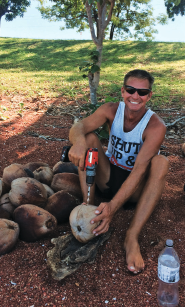
The edge of the anchorage is covered in mangoes and coconut trees and we took advantage, my DH having been previously frustrated using a machete, decided to take the drill. Two quick holes and the coconut juice flowed freely filling up four two litre containers; unfortunately the mango season was over.
Moving on
Checking the charts the Gulf becomes quite shallow but the rocky reefs disappear and sandbars become our main obstacles. Huge chunks are completely uncharted and soundings were unreliable as surely they had changed since Flinders sailed here. Most of the soundings are from the 60s but several from the 1880s were a surprise, making us feel like intrepid explorers.
A close watch of our sounder as we bounced south along the coast showed gentle contour changes with sandbar hazards near river mouths. At times it was so shallow we were forced to anchor two miles off the coast in only three metres of water. Leaving deck lights on at night seemed sensible.
We visited Ina Creek, the Watson River with its massive lung jellyfish population, onwards to the Kirk River where we caught salmon, flathead, cod and a huge jack to feast on. The Kendall River gave up our first Queensland barramundi and the Edward River ended our run of smooth anchorages with an unseasonal westerly making for three uncomfortable nights of swell. Shima became a stopover for wasps and crickets hiding from the winds.
The SE winds returned and we put full sails up on a comfortable beam reach to make good speeds of 9kts in 16kt of true as the depths reduced to five metres. A good lookout rewarded us with a sighting of a whale, probably an orca although he disappeared quickly aft of us. We were astonished to see him this far into the Gulf and in such shallow waters.

A no-name river rewarded us with more fish and an interesting camp called Topsy that looks well frequented by landlubbers. Further along we found a monument to a commercial mud crabber in the Nassau River. Again this river we explored by tender only as we were not confident yet to take Shima in without knowing where those troublesome sandbars are.
Our fortunes would change when we left here, as we approached the Staaten River. Slowing to find good bottom to drop the pick, our radio crackled to life. Scotty and Ian, commercial fishermen, had seen our sails and asked if we knew our way in, we did not. They told us to wait there and came whizzing out in their dory and escorted us in via a wobbly zig-zagging channel.
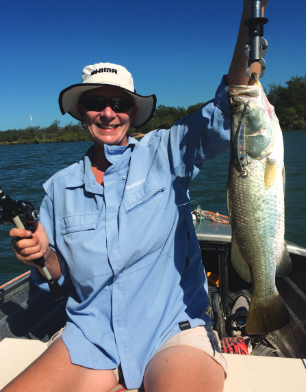
The wide deep Staaten was a superb find and here we were treated with gifts of mud crab, barra and a night of shenanigans aboard Shima. We gathered local knowledge, marks into the rivers, information of how sustainable and well cared for this fishery is and the amazing hospitality of these great guys, including a BBQ treat.
We bumped into them several times after this, enjoying several fun evenings, learning new things about their industry and their helpful and generous natures with a touch of larrikinism was fair dinkum Ozzie.
We reluctantly left for Karumba to collect Glen’s folks who drove their caravan into this fisherman’s port town.
Hi Karumba
Karumba usually has a population of 600 that is focused mainly on servicing the prawn trawlers, commercial crab, barra and mackerel fishing boats. It swells to significantly more as the grey nomads come here to fish these abundant waters in winter.
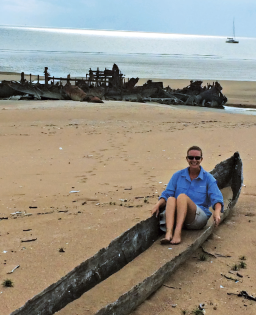
The caravan park is packed with tinnies and I counted 68 trailers at one boat ramp, this does put pressure on the services here. The grocery stores having difficulty keeping up with the surge in demand and the internet slowing to a dribble at sunset when the tourists start uploading their photos of that prized catch or the magnificent sunsets that this place can surely claim to be one of the best.
As they only have three to four yachts visit each year there is no public place for tenders, but the commercial fisherman allowed us to use the end of the spot on the jetty. Otherwise the other side is 30 minute time limit. There is also no access for fresh water unless you are going to purchase over 1000 litres of fuel on the fuel jetty.It is a short walk to the post office, magnificent butcher, chemist and a gift shop packed to the brim of fancy knickknacks and homemade soaps.
The anchorage on the Norman river is full of commercial boats, one local sailboat, several sneaky crocodiles and, at 6am, the wake of dozens of recreational fishermen wake you from your slumber. It is the only town in the Gulf that can actually see the Gulf from its shores. We spent time here fixing and maintaining, replaced our solar panels, added ultrasonic antifoul as sailing in the tropics with the crocs has meant our hulls have been neglected.
The chandler had everything we needed and more. Amazing Al at the post office was fantastic, holding and managing our mail.
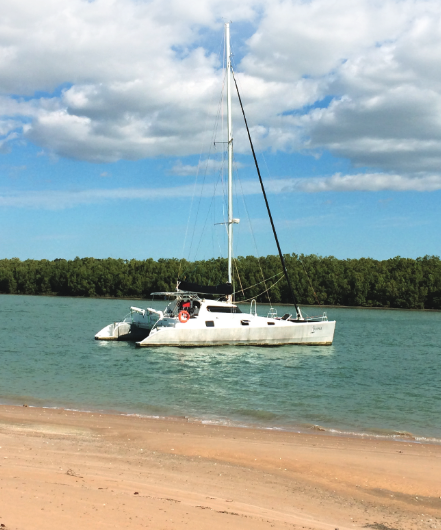
We took Glen’s folks for five days sail into Duck (Spring) Creek and the Smithburn Rivers as suggested by Scotty. It ended up being 20 days, it was so magical. Duck Creek was a gem, with good depths we steamed 1.5nm near an old abandoned camp full of rubbish, caravan debris, cars and various junk, but a lovely high set beach made it safeish for some land-based fishing. The boys cobbled together some crab pots, the girls made a makeshift area for cooking using the junk.
Recreational fishermen seemed amazed as they came round the bend to see a yacht in the middle of the river. We were heartened to meet the landowner a few days before departing as he came to survey the junk and informed us they were bringing trucks to remove the old camp and rubbish and clean the area back up.
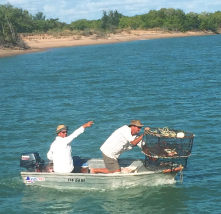
After dropping the folks off in Karumba we bumped into the Wildcard mackerel fishing boat. A wildly fun crew that convinced us to head to Sweers Island for a Rugby League State of Origin party. An early start with a break in the powerful SE winds we headed out to sea.
At 6 to 8kts we kept up with the wind and anchored in some uncharted waters north of Burketown, then the next day hauled the spinnaker out for the first time in two years. Some loose cogs in our brains tested to remember how to get her up and then as the breeze billowed her out we completed our journey in style.
Sweers Island is steeped in magic and history which the owners of the fishing resort, Tex and Lyn Battle, enthusiastically educated us about having spent the better part of 30 years living there. A narrow island, eight kilometres long, it is the largest island in the Wellesley group. Named in 1802 by Matthew Flinders after Salomon Sweers a council member of the East India Shipping Company who had asked Abel Tasman to explore the Gulf in 1644.
When sicknesses befall Burketown in 1868 William Landsborough evacuated the survivors to Sweers for 18 months, the first colony to inhabit the island. In 1841 Stokes discovered a tree with ‘Investigator’ carved into it from Flinders’ visit in 1802, he added ‘Beagle’ to it. The tree was damaged by a cyclone in 1887 and was removed to the Queensland museum in 1889, a plaque commemorates this site.
The quaint resort caters for avid fishermen who fly in year after year and get spoiled with fantastic food and hospitality. We enjoyed two weeks on anchor in the sheltered bay helping out with jobs on the island.
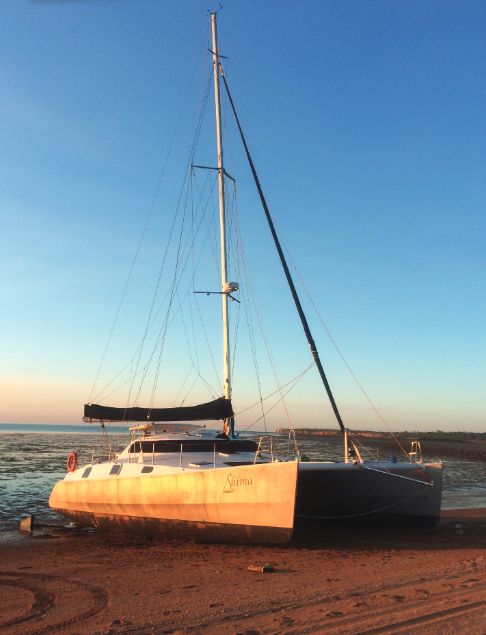
The beach was excellent and crocodile free so we took the opportunity to beach Shima and clean her bum in relative safety. The single tides that the lower part of the Gulf has, also made it exceptional. With 16 hours of run out and 8 hours of run in it gave us plenty of time to achieve our gaol, nice clean hulls again.
Evenings at the resort were full of fishing stories, watching the glorious sunsets, enjoying the various birds that inhabit the island and learning of the history of this place: caves inscribed by our forefathers, lime kilns from the gold days, remnants of the customs house and generally just enjoying the company.
This area is renowned for the rare morning glory cloud formation and as luck would have it we experienced one roll through. As September approached we knew we had to start heading north again to catch favourable wind, as the SE trades left, to start our journey to the east coast.
We farewelled our new friends and headed back to Karumba to collect our mail, restock and head north to Cape York ready to leave the west coast and head to the east.
Time to go and come back
The SE trade winds are still here and we are sitting in the Wenlock River, Port Musgrave just south of Seisia waiting for them to abate.
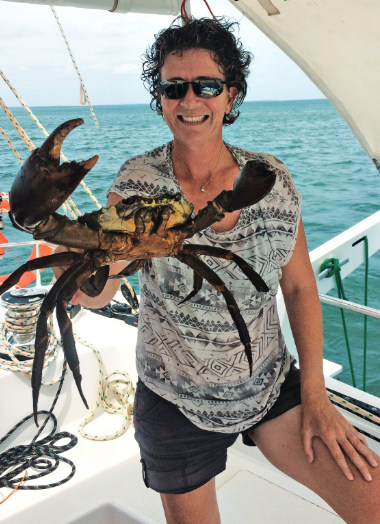
We cannot believe we missed this special place on our way down, a protected port with the small town of Mapoon that has a clinic, school and access to fuel, Cullen Point has water and many landlubbers that have come to experience remote fishing at its best, the beach is soft and sandy full of pelicans, sandpipers, oyster catchers and the sneaky looking Nankeen night heron.
We have seen numerous small crocodiles, mudskippers that are so big it looks like you could take a fillet off them and watched with wonder as the local aborigines walk the water in front of our anchorage spearing stingrays. The trees are pretty and a nice change from the mangrove-lined rivers.
We see sails in the distance and wonder if that means we are back on track and heading in the correct direction, but really I am happy to do it backwards. What a delight the Gulf has been, we will be back!
Justine and Glen had their dream built in the Phillipines and sailed her home in 2015. They gave up their, home and ties to land 12 months ago to sail Australia. With a love of the sea but no sailing experience they are self taught. With 6000nm under their belts they plan to add many more.
This article first appeared in the January 2017 edition of Cruising Helmsman.


























